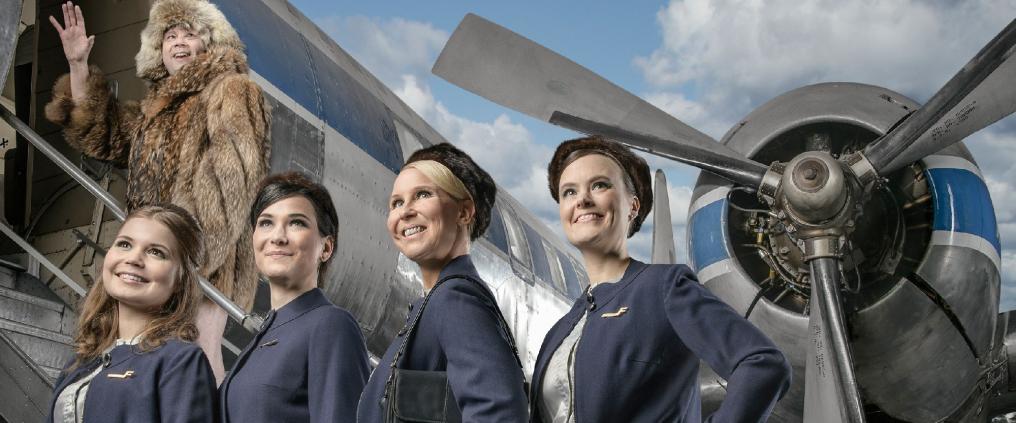Finnair cabin staff uniforms have tended to follow the latest trends and, typically, have always represented the latest developments in fashion design. Some of the outfits have even been given nicknames, such as the tea cosy, nun’s habit and ice crystal.
The first uniforms date back to 1947. Back then, the airline employed just six female cabin staff, who were invited to work together with the tailor responsible for creating their workwear. Later, the length of the hems and the height of the shoulder pads varied in keeping with the latest fashion diktats.
In 1969, inspired by the first flight to the moon, the cabin crew were given knee-length mini skirts and space-age silver tops. This was the year that also saw the launch of Finnair’s first flight route to America.
The outfits of the Finn Hostesses, who served on Finnair’s long haul flights in the 1970s, are of particular interest. High-profile Finnish fashion designers competed each year for the chance to design the long-skirted ensembles.
The first Finn Hostesses wore blue and white Suomen Trikoo velour dresses in a graphic print. Other iconic favourites include a long, beige leather skirt by Finnish leather brand Friitala. A bright yellow padded skirt was fittingly dubbed “the tea cosy”.
Over the years, the accessories have included mink hats, umbrellas, boots as well as silver jewellery by highly regarded Finnish designer Björn Weckström. Trousers were first introduced in the late 1990s.
Mature photography students running the show
The Blue Wings of Time photography exhibition is the work of students at the Institute of Visual Communications in Tampere. The students were given access to Finnair’s old uniforms from across the decades by the Finnish Aviation Museum, Finnair and former cabin staff themselves.
The vintage outfits were then worn by models, who posed in a series of period settings that had been perfectly recreated, right down to every last detail including hairstyles and airplanes. This painstaking effort produced eight photographs, created especially for the exhibition.
The exhibition also includes a short video that charts the production process. It allows visitors a glimpse behind the scenes to see where the images where shot and what goes into producing and photographing works of this sort. The video can also be viewed on the Finavia website.
For Finavia, the exhibition is part of its corporate responsibility agenda. The exhibitions and galleries under the Helsinki-Vantaa ArtPort concept are an opportunity for Finnish artists to showcase their work for both domestic and international audiences.
Aviation-themed photography on display since 2009
The idea, jointly conceived by Finavia, the Aviation Writers of Finland and Merja Ailama-Mäkitalon has over the years resulted in a series of exhibitions on aviation and flight-related themes that have showcased the works of both Finnish and internationally renowned photographers.
Many aviation enthusiasts visit Helsinki-Vantaa airport especially to see the exhibitions, which are updated twice a year.
First opened six years ago, the exhibition space is situated at the arrivals floor in Terminal 2 This area is open to all visitors to the airport and the free exhibition is open 24-hours a day.
The exhibition is produced by Finavia, Finnair, Kameralehti magazine, Aviation Writers of Finland, Color-Kolmio, Epson, Institute of Visual Communications, Merja Ailama-Mäkitalo and the Finnish Aviation Museum.
Photography enthusiasts are also encouraged to visit an additional exhibition on display at Helsinki-Vantaa’s Scenic Terrace that charts the changes undergone by the airport in the past six decades through nine different photographs.
More information about the exhibition can be found on the Blue Wings of Time website.



